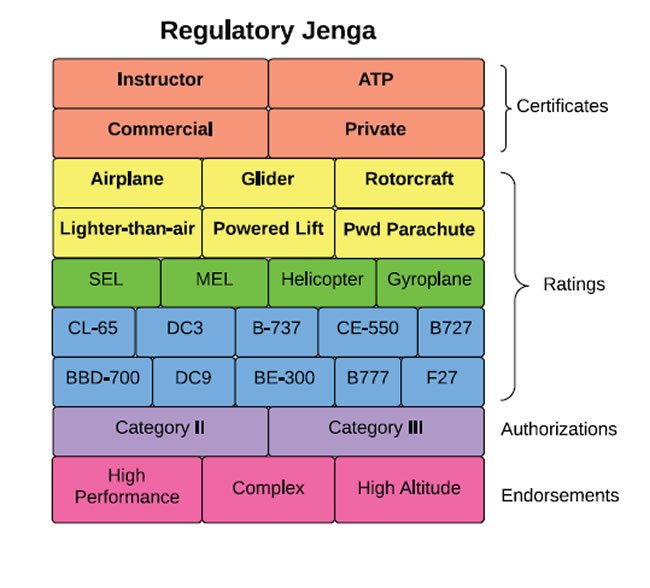What is that green piece of plastic sent to you by our friends in Oklahoma City called? If you answer license, crack open the regulations. The FAA issues certificates, not licenses. This bit of precision is useful for winning bar bets with flying buddies—serves them right for not reading IFR—as well as understanding the regulatory structure of certification; particularly, the advantages of certification over licensing.

Certificates vs. Licenses
Colloquially, certificate and license are used interchangeably even though the terms describe fundamentally different concepts. A certificate is a testament of truth, fact, or completion of a course of study. A birth certificate is a good example. It attests to the fact that someone was born. Importantly, certificates are hard to refute and true forever; a person must been born.
A license, on the other hand, is legal permission to do something. A fishing license gives me the privilege of watching trout sneer at my fly fishing technique. The permission granted in a license is of limited duration and not necessarily associated with a specific skill; otherwise I’d never get a fishing license.
Safety, order and common good requirements are underlying concepts in licensing and certification. When driving, it may seem a driver’s license is as easily obtained as one for fishing. In fact, a level of knowledge, skill and experience is required. The requirements promote safety and order. As a result, completing a course is necessary to obtain many licenses. Also, licenses often allow the holder certain privileges.
U.S. aviators earn certificates. Fellow aces across the pond and in other countries worldwide earn licenses. A global audience understands pilot licensing. Although ICAO standardizes global credentialing, differences exist between U.S. certificates and foreign licenses. For example, European licenses expire.
Certificates are Good
Certificates are the Aviat Huskies of credentialing—solid, robust and dependable. The federal government issues few certificates or licenses, yet the writing of regulations often mirrors the philosophical differences. For example, the regulations concerning a federal firearm license (FFL) begin by describing privileges. Conversely, the FAA regulations start by describing the course of study. Comparing an FFL to a pilot certificate will highlight the advantages of certification over licensing.
An obvious difference is that the FFL lasts only three years, while an FAA certificate—in most cases—lasts forever.
More important, a certificate provides significant protections for the holder. As a statement of fact, the burden is on the FAA to prove the fallacy of those “facts” when revoking a pilot certificate. The feds have “enforcement action” tools for addressing deviant pilots: administrative actions, reexamination and certificate action.
Administrative actions, predictably are internal agency steps resulting in either a letter of notice or letter of correction. The letters notify a pilot he did something wrong and possibly require some corrective action. These are a slap on the hand, the certificate isn’t at risk.
Still considered administrative action, the next level is reexamination, the FAA’s first stab at your certificate. An FAA examiner re-examines a pilot on the deficiencies that resulted in a violation. But, the thrust is easily parried by performing to PTS standards. A pilot who stumbles and doesn’t avert the jab is moved to the next step.
Enforcement action is where the feds take out a broad sword and start swinging at a certificate. Fortunately, many shields protect a pilot. If the FAA revokes a pilot’s certificate, he can appeal the decision to an NTSB judge. This is an important step because it takes the case outside of the administration. The NTSB judge’s ruling can be appealed to the full NTSB board and their finding appealed to the U.S. Court of Appeals. Potentially, three agencies must agree for a certificate action to be upheld.
Compare all of the protections for a pilot certificate action to an FFL. If the Director finds a holder of an FFL violated a regulation, he issues a revocation letter. A licensee can appeal by requesting a hearing with the agency’s Director of Industry Operations. The DIO’s findings, following the hearing, are final; no appeals and no other agency involved. It’s not often a bureaucrat is going to find a colleague within the same bureau wrong.

Add-ons
Certificates occupy the top of the regulatory Jenga tower. Below lie ratings, authorizations and endorsements, which add privileges to a certificate.
Every license comes with a rating. Aircraft categories, classes and types are all ratings. Likely you earned your private pilot certificate with airplane and single-engine ratings, which is a little confusing. For categories with classes, a new category rating always comes with a class rating. You can’t earn a rotorcraft rating without being in either a helicopter or gyroplane. Some categories, like glider, don’t have any classes.
The instrument rating is an oddball because it adds privileges to a specific rating—potentially a category or class. The instrument airplane rating applies to a category, airplane, while instrument helicopter and instrument power lift apply to classes.
Lower on the totem pole are authorizations. For 91 fliers (not including subpart k), only two authorizations exist, CATII and CATIII. (Interestingly, an authorization is not required for precision radar monitoring (PRM) approaches. A 91 aviator only needs to comply with the “attention all users page.”) Additional authorizations are available for 91(k), 121, 125, 129 and 135 operators where many normal maneuvers—such as circling approaches—are restricted and require an authorization.
Last is the lowly endorsement. These confirm completion of a course of study before it is verified during a practical test. Endorsements also add privileges which the feds graciously allow instructors to grant.
Oddballs
A couple oddballs inhabit the regulatory universe. Student pilot and flight instructor certificates both expire, as does a medical certificate. These should probably be licenses. Additionally, a certificate issued on the basis of a foreign license will expire, since the underlying document lapses.
A real weird duck is the commercial lighter-than-air certificate with airship rating. This certificate allows a pilot to fly IFR without having an instrument rating. Instead, instrument tasks are incorporated in the commercial PTS. If an applicant already has an instrument rating, they are good to go. Otherwise, the examiner will test the applicant on instrument and commercial standards.
Cleaning up the Mess
Language is messy. Using it in new and creative ways is part of our evolution. Trying reading Edmund Spence’s The Faerie Queene and you’ll quickly see how much language changes. But, imprecision also causes confusion and misunderstanding. So why not do it right?
That green piece of plastic from the feds is your pilot certificate. On the back, category, class and likely instrument ratings are listed. Adding either a category or class is getting a new rating. Most other privileges come from the pen of an instructor writing an endorsement.
Next time you’re sipping free beer won off your flying buddies, do the nice thing and order them a subscription to IFR as a thank you.
Jordan Miller, a pilot for a major U.S. airline, spends way too much time with a thesaurus and dictionary.





